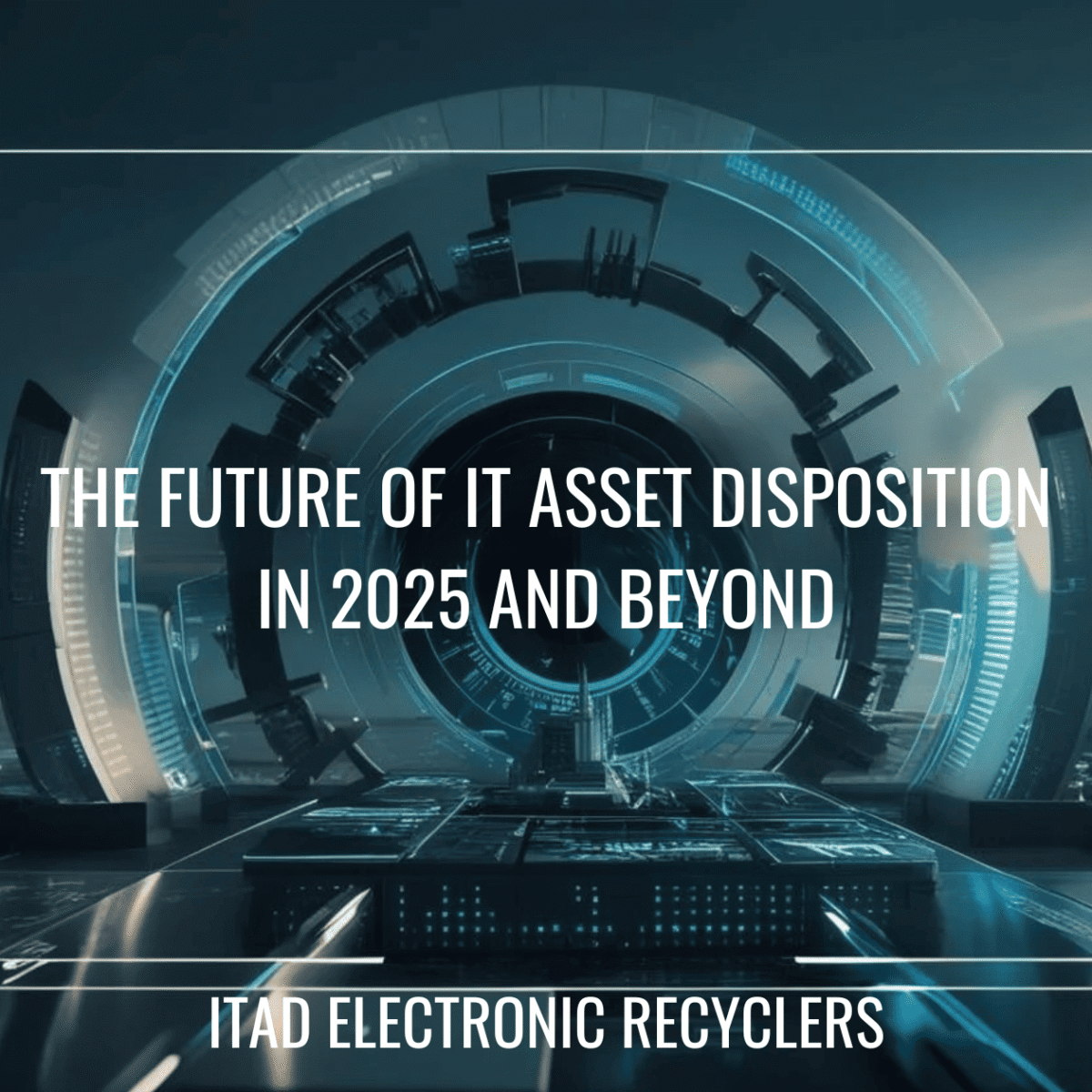Introduction
The IT Asset Disposition (ITAD) industry is evolving rapidly as businesses face increased cybersecurity threats, stricter environmental regulations, and growing corporate sustainability commitments. With the shift toward remote work, cloud computing, and circular economy initiatives, companies must stay ahead of ITAD trends to ensure secure, compliant, and cost-effective IT asset disposal.
As we move into 2025 and beyond, businesses must adapt to emerging ITAD technologies, new e-waste regulations, and evolving best practices for secure data destruction. This guide explores the key trends shaping the ITAD industry and how businesses can prepare for the future of IT asset management and disposal.
📌 Related: E-Waste Legislation: What Businesses Need to Know in 2025
1. The Rise of AI and Automation in ITAD
Artificial intelligence (AI) and automation are revolutionizing IT asset management and disposition, helping businesses track, secure, and dispose of IT assets with greater efficiency and accuracy.
How AI is Transforming ITAD:
- Automated IT Asset Tracking – AI-driven software can monitor IT asset lifecycles, identifying when devices should be upgraded, resold, or recycled.
- Predictive Analytics for IT Asset Value Recovery – Machine learning models assess resale potential, helping businesses maximize returns on retired IT assets.
- AI-Driven Data Erasure Verification – AI ensures comprehensive data sanitization by verifying that sensitive information has been securely erased before IT asset resale or recycling.
📌 link: NIST 800-88 Data Destruction Standards
2. Stricter Global E-Waste Regulations
Governments worldwide are tightening e-waste regulations, requiring businesses to improve IT asset tracking, data security, and environmental compliance. New and expanded laws in 2025 include:
- The Right to Repair Laws (U.S. & EU) – Requires manufacturers and businesses to extend the lifespan of IT assets by providing access to repair manuals and spare parts.
- Basel Convention Update (Global) – Expands restrictions on e-waste exports, requiring businesses to dispose of IT assets locally through certified recyclers.
- U.S. State-Level E-Waste Mandates – States like California, New York, and Texas are increasing penalties for improper IT asset disposal and requiring businesses to submit detailed e-waste reports.
To avoid legal and financial risks, businesses must implement a structured ITAD process that ensures compliance with evolving regulations.
3. A Shift Toward Circular Economy Practices
Companies are moving away from the traditional “take, use, dispose” model and embracing circular economy principles to reduce e-waste and recover valuable materials.
Circular Economy ITAD Strategies Include:
- Refurbishing and Reselling IT Assets – Instead of discarding old hardware, businesses repair and resell IT assets to extend their lifespan.
- Material Recovery and Recycling – Secure ITAD providers extract gold, silver, copper, and rare earth metals from electronic devices, reducing the need for new mining.
- IT Equipment Take-Back Programs – Companies implement trade-in programs to collect, refurbish, and redistribute used IT devices.
By adopting a sustainable ITAD strategy, businesses lower disposal costs, generate additional revenue, and reduce their environmental impact.
📌 Related: The Role of E-Waste Recycling in a Circular Economy
4. Growing Corporate Focus on ESG and Sustainability
Environmental, Social, and Governance (ESG) reporting is now a business priority, with investors and stakeholders demanding greater transparency in IT asset disposal. Companies that fail to demonstrate eco-friendly ITAD practices risk losing contracts, damaging their reputation, and facing financial penalties.
How ESG Impacts ITAD in 2025:
- Increased Pressure for Sustainable IT Asset Management – Businesses must ensure their ITAD processes align with sustainability goals.
- Mandatory E-Waste Reporting – Some industries now require public disclosures of IT asset disposal methods.
- Corporate IT Recycling Initiatives – More companies are partnering with certified ITAD providers to meet sustainability objectives.
📌 Related: How ITAD Can Help You Meet Your ESG Goals
5. The Expansion of Remote IT Asset Disposition
With remote and hybrid work models becoming the norm, businesses face new challenges in tracking, retrieving, and securely disposing of IT assets used by off-site employees.
How Businesses Are Adapting ITAD for Remote Work:
- Prepaid Secure IT Asset Shipping – Employees receive prepaid packaging to return old laptops, hard drives, and devices securely.
- Drop-Off Locations and ITAD Collection Centers – Companies establish regional drop-off points to streamline remote IT asset disposal.
- Remote Data Destruction Software – IT teams use cloud-based tools to erase sensitive data from off-site devices before collection.
📌 Related: ITAD and the Rise of Remote Work: How to Securely Dispose of Off-Site IT Assets
6. Increased Demand for Certified ITAD Vendors
Not all ITAD providers meet industry standards for security, compliance, and environmental responsibility. As IT asset disposal regulations tighten, businesses are prioritizing certified ITAD partners to avoid risks.
Key Certifications for ITAD Providers in 2025:
- R2v3 (Responsible Recycling Certification) – Ensures ethical IT recycling and secure data destruction.
- e-Stewards Certification – Guarantees environmentally responsible IT asset disposition.
- ISO 27001 (Information Security Management) – Confirms adherence to strict cybersecurity standards.
Companies must vet ITAD vendors carefully to ensure compliance with new regulations and protection of sensitive business data.
📌 Related: How to Choose an ITAD Vendor You Can Trust
Conclusion: Preparing for the Future of ITAD
As IT asset disposal becomes more regulated and technology-driven, businesses must adopt proactive ITAD strategies to stay ahead of compliance requirements, data security risks, and sustainability demands.
By embracing AI-driven asset tracking, circular economy practices, and remote ITAD solutions, companies can:
- Enhance data security with AI-powered erasure verification.
- Reduce regulatory risks by staying compliant with global e-waste laws.
- Improve sustainability through refurbished IT asset programs.
- Maximize asset value with predictive ITAD analytics.
At IER ITAD Electronics Recycling, we specialize in secure, compliant, and environmentally responsible IT asset disposition. As a trusted provider of ITAD services and electronics recycling in Colorado Springs, we help businesses protect their data, meet regulatory standards, and reduce e-waste. Contact us today to ensure your business is prepared for the future of ITAD.





